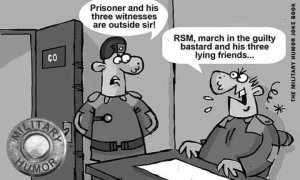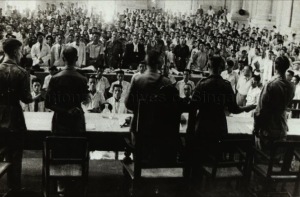Blog Archives
Further Trial Information
The Allies also established the United Nations War Crimes Commission (the UNWCC) in 1943. The UNWCC collected evidence on Axis war crimes and drew up lists of suspected war criminals for Allied prosecution after the war. In 1944, a sub-commission of the UNWCC was established in Chungking to focus on the investigation of Japanese atrocities.
By the later part of 1945, the Allied Powers had agreed on war crimes trials as a means of pursuing justice. This set the stage for post-WWII trials. A select group of higher-ranking military and political Axis leaders would be jointly tried by the Allies at the Nuremberg Trial (19 November 1945 – 1 October 1946) and the Tokyo Trial (3 May 1945 – 12 November 1945). In addition and separate from the Nuremberg and Tokyo Trials, individual Allied Powers and countries held national trials of Axis defendants in various locations, including Singapore.
Upon Japan’s surrender, the Allies began organizing war crimes investigations and prosecutions throughout Asia. At the Tokyo Trial, the Allies prosecuted only 28 high-ranking ‘Class A’ suspects from various government and military departments on charges linked to the waging of war and war crimes. Hundreds of lower-ranking ‘Class B’ and ‘Class C’ suspects of diverse ranks were prosecuted at other Allied trials operating across Asia.
It is hard to arrive at the exact number of Allied trials held in Asia, as there continues to be access restrictions to some national trial records. Some latest estimates of the number of war crimes trials held by different national authorities in Asia are as follows: China (605 trials), the US (456 trials), the Netherlands (448 trials), Britain (330 trials), Australia (294 trials), the Philippines (72 trials), and France (39 trials). In 1956, China prosecuted another four cases involving 1062 defendants, out of which 45 were sentenced and the rest acquitted. The Allies conducted these trials before military courts pursuant to national laws of the Allied Power concerned. Altogether 2244 war crimes prosecutions were conducted in Asia. 5700 defendants were prosecuted: 984 defendants were executed; 3419 sentenced to imprisonment; and 1018 acquitted.
The British conducted national war crimes trials (the Singapore Trials) pursuant to a 1945 Royal Warrant adopted by the British executive under royal prerogative powers (1945 Royal Warrant). The British military was given the responsibility of implementing these trials in different locations across Asia and Europe. 330 trials were organized by the British military in Asia. Of these, 131 trials were conducted in Singapore.
As of mid-1946, the British military had established 12 war crimes courts in Singapore, Kuala Lumpur, Rangoon, Hong Kong, and Borneo. Eight of 12 courts established were located in Singapore. There were also ‘travelling courts’ that made their way to particular locations to hear a case.
Singapore served as the base for the British military’s war crimes investigations and prosecutions in Asia. Investigations were conducted out of Goodwood Park Hotel. Post-war conditions in Singapore posed many challenges to the organizing of these trials. There was a shortage of food, basic necessities, and qualified personnel in post-war Singapore.
Trials conducted in Singapore concerned not only Japanese military atrocities perpetrated in Singapore but those committed in other parts of Asia (see Tials Chart 1 above).
A substantial number of trials addressed the abuse and neglect of POWs and civilian detainees in prisons and camps, such as Changi Prison, Sime Road Prison, Outram Road Gaol, and Selarang Barracks.
Click on images to enlarge and read.
##############################################################################################
Military Humor –

##############################################################################################
Farewell Salutes –
Elbert Ausley – Schaumburg, IL; US Navy, WWII, USS Gambier Bay survivor
Donald Campbell – Ponca City, OK; US Army Air Corps
William Duffy Sr. – Shannondell, PA; US Army, WWII, ETO, Lt. Colonel
Raymond M. Giles – Srague, WA; US Army Air Corps, WWII, PTO, P-38 pilot, Lt. Col. (Ret.)
Bertha Holtwick – Boston, MA; US Army WAC, WWII, nurse
Jack Isaacs – USA; US Army Air Corps, WWII, ETO, 194/17th Airborne Division
James Milstead – Chicago, IL; USMC, WWII, CBI
Cyril Newdick – Maketu, NZ; RNZ Air Force # 79638, Sgt.
Emery Sutton – FL; US Navy, WWII, PTO / ETO, USS Wasp
C-130 Hercules crash victims in Australia
Rick A. DeMorgan Jr. – Navarre, FL; US Air Force, Flight Engineer / Firefighter
Paul Clyde Hudson – Buckeye, AZ; USMC, Naval Academy graduate, Lt. Col (Ret. 20 y.) / Firefighter, 1st Officer
Ian H. McBeth – Great Falls, MT; WY & MT National Guard, Lt. Col. / Firefighter, Captain
##############################################################################################

















